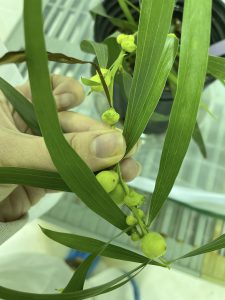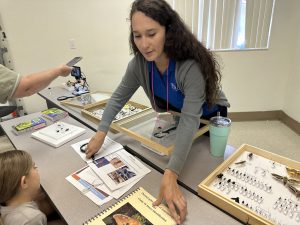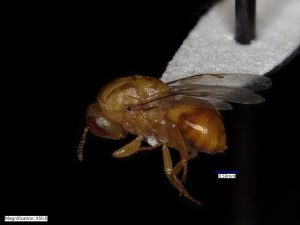
FORT PIERCE, Fla — A Ph.D. student has won a global award for her work to prevent an invasive tree from encroaching on Florida’s natural landscapes.
Sara Salgado studies at the UF/IFAS Norman C. Hayslip Biological Control Research and Containment Laboratory (BCRCL) at the Indian River Research and Education Center in Fort Pierce, Florida. In a nearby Port St. Lucie wooded area, a stand of 190 earleaf acacia trees thrives. The trees’ branches are brittle with yellow, fur-like blooms. The trees reproduce in multiple Florida locations, grow taller yearly and shade out the natural scrub environment.
For Salgado’s groundbreaking work as a graduate research scientist, officials with the International Organization for Biological Control (IOBC) will recognize her with its Global Early Career Award.
In early May, leaders of the IOBC will present Salgado with the prestigious award in Puerto Iguazú, Argentina, as part of the organization’s 16th International Symposium on the Biological Control of Weeds.

Invasive Earleaf Acacia tree
“Earleaf acacia, Acacia auriculiformis, threatens native species and the ecosystem,” said Salgado. “Just like other invasive plants, such as the Brazilian peppertree, Schinus terebinthifolia, and melaleuca, Melaleuca quinquenervia, earleaf acacia infestations can bring detrimental economic and environmental impacts to Florida’s ecosystems.”
“Sara’s work with a tiny wasp that attacks the pest plant will reduce the environmental and economic impact of the invasive earleaf acacia in Florida and beyond. Sara’s passion for science and understanding how invasive organisms shape our world make her a worthy recipient of this award,” said Dr. Carey Minteer, an assistant professor of entomology at the UF/IFAS BCRCL, who supervises Salgado’s graduate program.
Research conducted in the Minteer Biological Control of Weeds Lab
Minteer, her research team, and collaborators at the United States Department of Agriculture Agricultural Research Service and the Commonwealth Scientific Industrial Research Organisation are investigating biological control agents for the earleaf acacia now — before it spreads over hundreds of thousands of acres. Biocontrol agents feed on invasive plants, oftentimes reducing plant abundance, and returning the “natural control” seen in their native range. The earleaf acacia tree’s native range is Australia, Indonesia and Papua New Guinea.
Earleaf acacia is not as prevalent as other invasive plants, but it is spreading quickly in recent years, Salgado said.

Salgado investigates insects in the regions where invasive plants are native —or their home region where they are often not problematic. The scientists acquire permits to bring the insect species that feed on the trees to the Minteer lab for study inside a high-security containment lab and greenhouse.
Salgado researches and evaluates a small wasp to verify that it will feed only on the invasive earleaf acacia tree. After rigorous tests and approvals by state and federal officials, the scientists hope to eventually release the new biological control of this tree in Florida.
“One focus for my research involves identifying local insects who feed on the earleaf acacia tree and evaluating a psyllid native to Australia that is already present in Florida,” said Salgado.

The bud-galling wasp
Other objectives for the robust research program are to determine the host range of a bud-galling wasp, Trichilogaster, from Australia, a candidate species for biological control of the earleaf acacia tree. Part of the work with this species will include a simulation interaction between the wasp and earleaf acacia to ascertain if the two species will survive and cohabitate in Florida’s climate, said Salgado.
“Earleaf acacia is a highly invasive plant that can thrive in wet environments and disturbed areas. This is one of our concerns as the Everglades is a sensitive and unique ecosystem in Florida, that we want to protect,” Salgado said.
Salgado said she has made a lifelong commitment to advance biological control to stem the damage invasive species have leveled on natural habitats. Florida is a living laboratory for invasive species.
A native of Ecuador
Salgado is from Ecuador, where invasive species are a major concern. Invasive species have caused major environmental damage in the Galapagos islands of Ecuador. Among her academic awards are a Master of Science thesis with distinction from Rhodes University in South Africa; a Best Thesis award from Zamorano University in Honduras; a 2nd Place scientific presentation award from the Entomological Society of America; and, a 1st Place presentation award from the Florida Invasive Species Council.
The IOBC was founded in 1956 “to promote environmentally safe methods of pest and disease control in plant protection,” according to the organization’s website.
 14
14
